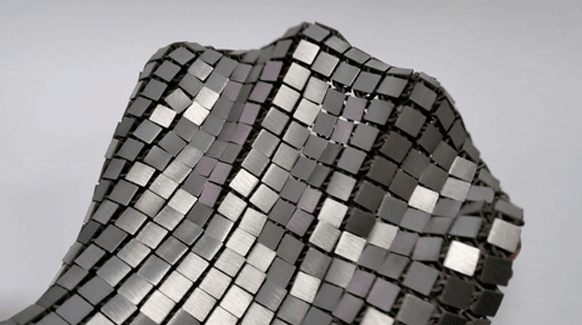
This innovation and the 4 D manufacturing technique is wonderful. We know we need these combinations but have never been able to do anything except work arounds. This changes all that.
Now imagine all this printed out in nano scaled fabrics made of say titanium that only weighed a few grams. That could be a perfect space suit.
The point to consider is just how fast this is advancing. First 3 D printing machines are less than a decade old. Now we can imagine an industrial grade cloth making device.
.
NASA'S WILD FABRIC IS BASICALLY CHAIN MAIL FROM THE FUTURE
NASA/JPL-CALTECH
https://www.wired.com/story/nasa-fabric-chain-mail-from-the-future/
TRAVELING TO OUTER space is an exercise in efficiency. At $10,000 per pound onboard, it pays to keep things light. But space is also an incredibly complex environment, requiring tons of hefty equipment just to exit the atmosphere. To minimize the weight of its payload, NASA has experimented with inflatable materials that can balloon into habitats, and tangles of lightweight rods that can shift shape on different terrains. Now, designers at NASA’s Jet Propulsion Laboratory have developed a foldable fabric that could pull triple duty during outer space missions.
Researchers at JPL spent the last two years developing a metallic space fabric made of interlocking stainless steel squares. It looks like chain mail, but unlike the ancient armor, NASA’s fabric isn’t welded together. Instead a 3-D printer extrudes stainless steel as a continuous sheet of material with different properties on each side. From the front of the fabric, rows of shiny, flat squares can reflect heat and light. On the back, a series of interlocking loops help the fabric absorb heat. Together, the single piece of material acts like a super-strong shield, protecting astronauts and spacecrafts from outer orbit’s deadly obstacles.
The fabric isn’t special in its functionality, per se; NASA already employs materials on its spacecrafts to reflect heat, absorb heat, and protect from flying debris. But until now, NASA didn't have a single material that could do all three. “We wanted to see if a structure could do something beyond being a static piece of material,” says Raul Polit Casillas, a systems engineer at JPL who worked on the new fabric.

NASA/JPL-CALTECH
NASA could bake multiple properties into the single material thanks to 4-D printing, a burgeoning manufacturing technique that uses a 3-D printer to layer multiple textures and geometries into a single design. MIT researcher Skylar Tibbits coined the phrase several years ago to show how a 4-D printed material could shape-shift or self-assemble. Using 4-D printing, for instance, engineers could program a piece of metal to unfold at a certain heat or design a plastic to expand or contract under certain environmental conditions. Or, in the case of NASA's space fabric, a fabric with flexible geometry that can both reflect and radiate heat.
Unlike sheets of metal, the chain mail can bend and fold with little effort while still remaining strong. This makes it a valuable material onboard a spacecraft full of stiff, hard materials. Polit Casillas says astronauts could print the material onboard the spacecraft and use it to deflect heat on deployable components like antennas and reflectors. It could just as easily be used on missions to
Jupiter’s moon Europa, where the rough side would act like tire treads on the moon’s icy surface, or as armor for astronauts and vessels.
“Of course," Polit Casillas adds, "you could use this for fashion, too.”
NASA is still at the beginning stages of its 4-D printing explorations, but Polit Casillas expects that his team will eventually develop materials with more advanced built-in capabilities. Soon, you might see fabrics that move electrons, transfer energy, and shape shift. The point, he says, is to “increase the science we can do per kilogram.” Doing more with less doesn't always result in the best product, but in this case, it lends itself to some very cool science.
RELATED VIDEO
DESIGN
Boeing Blue is the Latest in a Long Line of Space Suits
Boeing Blue, the new space suit designed for the company's Starliner capsule, is the most recent update to a linage of suits that go back to the beginning of the space age.
No comments:
Post a Comment